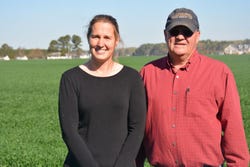
Glenn Pendleton is confident that within the next five years 100-bushel soybeans will be achieved across North Carolina.
Pendleton and his daughter Renee Otts farm in partnership and aim to break the 100-bushel-per-acre soybean barrier this year.

Glenn Pendleton and his daughter Renee Otts.
Glenn Pendleton Family Farms in Pasquotank County achieved North Carolina’s highest recorded soybean yield ever last year with 93.3 bushels per acre.
“Our target for now is 100 bushel beans,” Pendleton says. “I think it’s attainable. In the near future I think we are going to see 100 bushel beans as a common achievement for more growers because of improved varieties, technologies, fungicides, genetics and better farming practices.”
The Pendleton family won last year’s annual North Carolina Soybean Yield Contest that is administered by North Carolina State University Cooperative Extension Service and sponsored by the North Carolina Soybean Producers Association. The contest is based on yield from a measured and verified three-acre plot.
The Pendleton’s award winning entry of 93.3 bushels per acre, bested the old state yield record of 92.9 bushels per acre by .4 bushels per acre. The previous record was set in 2006 by Phil and Mike McLain of Irdell County in 2006.
Group 3 beans harvested on time
Both Renee and Glenn credit their record breaking yields to Group 3 beans that were harvested on time. “The timing of picking really helped us. Had we waited two weeks later the rains that came would have cut our yield,” Pendleton notes.
As the Pendleton’s shoot for 100 bushel soybeans, they are fine tuning what they do to reach that goal. “We know the yield potential is there,” Pendleton says.
Achieving top yields begins with good soil, Pendleton stresses. But even in less than stellar soil, excellent yields can be achieved with good management. “You have to know your soil capabilities. Treat your soil properly, and you will get good production. The soil is what’s going to produce those high yields,” he emphasizes.
Renee adds that soil testing is critical. “We do soil samples every two years. We pay close attention to the soil pH, basic nutrients, and micronutrient indexes. Micronutrients are very important” she says.
Pendleton adds that they do add a little more fertilizer than the soil tests call for, but not an excessive amount. “We like to bring our indexes up a little higher than what is recommended by the state lab,” he explains.
The Pendletons are dryland farmers and in their area of North Carolina too much water tends to be a bigger problem than not enough water. “Good drainage is necessary to get good bean yields around here. Our land is flat so we try to prevent pot holes and pockets of water by putting surface drains in the right places,” Pendleton says.
About two-thirds of their land is conventional tillage with the other third no-till. “With some of our land it pays to break up the soil. With other land, it produces well no-tilled.”
This year, the Pendletons plan to plant 25 percent of their soybean crop in Group 3 soybeans, and the rest in Groups 4 and 5. “We don’t want too many Group 3’s because they are coming off when corn is being harvested,” Pendleton says. “We double crop a third of our soybeans with wheat.”
Variety selection is critical and the Pendleton’s look at plot demonstrations from both the seed companies and North Carolina State University’s official variety trials in their area. “We like short to medium, bushy beans with high yield potential,” Pendleton explains. “If they bush out, I can cut my plant population back 10 to 20 percent.”
All of the seed they plant is treated with fungicide, which Pendleton believes is critical for top yields. Timely foliar fungicide applications are also important. In their contest plot last year, they made an early insecticide and fungicide application to control stink bugs and foliar diseases.
The final step to achieving top yields is harvesting. The Pendletons work hard to harvest their beans. Although it is not always possible, they try to harvest them the first time they dry to 14% moisture or less. They also have used a draper header on their combine the last 3 years. “I believe the draper header saves me a bushel or two more than the conventional header I used to run,” Pendleton says.
Renee and Glenn plan to enter the soybean contest again this year. And if all goes as planned and the weather cooperates, they hope 100+ bushel beans will be their contest entry. “That’s the goal we are aiming for,” Pendleton says.
About the Author(s)
You May Also Like






